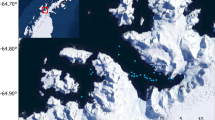Abstract—
Remote monitoring of the behavior of the Baikal seal was carried out for the first time on one of the main islands of the archipelago of the Uskan Islands, allowing for a large amount of video material to be obtained and analyzed over four seasons (2012, 2014, 2018, and 2019). The summer–fall haul-outs of Baikal seals on coastal hauling grounds are classified as communities with the elements of hierarchical and social relations, elements of which occur during their feeding season in the pelagic zone of Lake Baikal in the form of relatively independent groups of animals. The video recordings clarify the patterns of Baikal seal approach to the hauling ground area, the ways the animals haul out ashore, and the main elements of animal behavior, under both peaceful interactions and aggressive relations with their counterparts. The main elements of comfortable behavior include body care in the form of scratching of various body areas (rubbing of the back against the rock is first described for the Baikal seal); sleep (rest); and ways of thermoregulation under various conditions of hauling out on rocks. The author emphasizes the frequency rate of body stretching and yawning as a way to restore adequate blood flow to the muscles after sleep or a period of low mobility. The well-developed mimic serves the animal to express a variety of emotions. Animals are generally reluctant to leave the hauling grounds, on average spending approximately three hours per approach, while some animals, occupying particularly advantageous positions, can stay almost the entire daylight hours in the open air. Partial renewal of the haul-out composition (“rotation”) is observed during the day. The haul-out is completely renewed under the panic-driven flight. In addition to humans, only seagulls are capable of chasing the seals from rocks, but the seals do not respond to them in panic, but are wary. The authors emphasize the role played by individual behavior, depending on the individual psychological response, rather than physical conditions. The main known elements of aggressive behavior of the Baikal seal, such as lightning-fast head thrusts towards the enemy, strikes with flippers or claws, splashing with water, biting, etc., are displayed in response to fear experienced by the animal. The concepts of fight, quarrel, and pushing are distinguished. The Baikal seal is considered quite aggressive toward its counterparts and can inflict small injuries on them. An important role is played by “touching,” tapping, and scratching neighbors in the haul-out, as well as pacifying displays/demonstrations, including head retraction drawing into the neck, turning away the head or glances, and raising and holding the head upright. The latter two elements of behavior, in our view, express (display) reluctance to continue the fight (i.e., peaceful disposition), whereas the first element is submission.













Similar content being viewed by others
Notes
“Group behavior, which is a joint activity framing the life of a community, is based on various forms of interrelationships between separate individuals with each of them making its own contribution by interacting one way or another with other individuals” (Tinbergen, 1969, p. 151).
Sources are largely not mentioned by us when making reference to our review (communication 2).
REFERENCES
Baranov, V.I., Baranov, E.A., Elagin, O.K., Petrov, E.A., and Shoshenko, K.A., Blood flow in the skin and subcutaneous fat of the Baikal seal, Zh Evol. Biokhim. Fiziol., 1988, vol. 24, no. 3, pp. 437–444.
Baranov, V.I., Elagin, O.K., Petrov, E.A., Chermnykh, N.A., and Shoshenko, K.A., Regional blood flow during cooling and heating in the Baikal seal, Ekologiya, 1988a, no. 6, pp. 75–77.
Baranov, V.I., Elagin, O.K., Korokhov, V.P., Petrov, E.A., Chermnykh, N.A., and Shoshenko, K.A., Organ circulation of the Baikal seal during temperature changes and diving, Bionika (Ukraine), 1992, no. 25, pp. 98–108.
Chauvin, R., Le Comportement Animal, Paris: Masson et Cie, 1969.
Ivanov, T.M., Baikal seal, its biology and harvest, Izv. Biol.-Geogr. Nauchno-Issled. Inst. Vost.-Sib. Gos. Univ., Irkutsk, 1938, vol. 8, nos. 1–2, pp. 5–119.
Khamas, W.A., Smodlaka, H., Leach-Robinson, J., and Palmer, L., Skin histology and its role in heat dissipation in three pinniped species, Acta Vet. Scand., 2012, vol. 54, p. 46.
Nesterenko, V.A. and Katin, I.O., Larga Phoca largha v zalive Petra Velikogo (Larga Phoca largha in Peter the Great Bay), Vladivostok: Dal’nauka, 2014.
Odum, E., Fundamentals of Ecology, Philadelphia: Saunders, 1971, 3rd ed.
Petrov, E.A., Baikal’skaya nerpa (Baikal Seal), Ulan-Ude: Ekos, 2009.
Tinbergen, N., Povedenie zhivotnykh (Animal Behavior), Moscow: Mir, 1969.
Author information
Authors and Affiliations
Corresponding author
Ethics declarations
The authors declare that they have no conflicts of interest. This article does not contain any studies involving animals or human participants performed by any of the authors.
Additional information
Translated by E. Kuznetsova
Rights and permissions
About this article
Cite this article
Petrov, E.A., Kupchinsky, A.B., Fialkov, V.A. et al. The Importance of Coastal Hauling Grounds in the Life of the Baikal Seal (Pusa sibirica Gmelin 1788, Pinnipedia): 4. Behavior of Seals on Coastal Hauling Grounds of Tonkii Ushkan Islet (Ushkan Islands, Lake Baikal), Based on Video Observations. Biol Bull Russ Acad Sci 49, 992–1010 (2022). https://doi.org/10.1134/S1062359022070160
Received:
Revised:
Accepted:
Published:
Issue Date:
DOI: https://doi.org/10.1134/S1062359022070160




